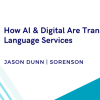As we enter a new year, it’s always fun to gaze into our crystal balls and anticipate the key trends and forces that will shape our industry in the coming year. Granted, given the pace of change and disruption that has come to characterise the outsourcing space, the business of prognosticating is becoming an increasingly risky one. That said, here are some thoughts and observations – in no particular order – from Alsbridge regarding what to expect in the coming twelve months.
For one thing, we expect repatriation of services to make a comeback in 2016. In past years, we’ve observed insourcing rates spike in response to disappointment with service providers and lack of measurable results. What we’re seeing now is a bit different, as enterprises benefit from lessons learned and take an increasingly mature and strategic approach to repatriation. Rather than taking services back in-house as a knee-jerk reaction, businesses are focussing on owning areas such as intellectual property management that can yield a competitive advantage when delivered in-house.
As such, insourcing is emerging as one component of an overall strategy aimed at a selective “right-sourcing” approach that identifies specific functions that are better suited to in-house management. In this sense, growing interest in repatriation is more a sign of increased maturity rather than an indictment of outsourcing. That said, in some cases businesses still pursue repatriation for the wrong reasons. Moreover, clients often fail to anticipate and prepare for the significant costs and risks involved in transferring services back in-house.
Another trend we anticipate is a re-emergence of offshore captive operations. In recent years, we’ve seen disillusionment with captives, as client organisations have struggled to manage resources in offshore locations. Today, we’re seeing enterprises leverage the process maturity experience they’ve gained in working with outsourced offshore teams. Establishing a captive, the thinking goes, gives clients greater contractual flexibility and reduces costs by removing the provider’s margin.
Prediction number three: dedicated vendor management offices (VMOs) will emerge as a leading practice. As clients struggle to manage increasingly complex multi-vendor service delivery models, the VMO will offer a way combine a high-level, enterprise-wide view of service delivery together with insight into operational details and multiple touch points between different providers in the service delivery chain. More specifically, the VMO will enable the standardisation, consistency, visibility and transparency between stakeholders that are essential to achieving true value from outsourcing.
We also expect that the concept of “bi-modal” IT will gain increasing prominence in 2016, as clients recognise the need to take different approaches to managing infrastructure and “run the business” IT on the one hand, and agile development and “change the business” IT on the other. The bi-modal model will help clients implement commercial and contractual mechanisms with vendors to clearly delineate the roles of the respective groups and to optimise the contributions of each to the business.
While the distinction between run-the-business and change-the-business IT is nothing new, effectively managing each team – as well as managing the relationship between the two teams – is becoming increasingly important. On the one hand, as technology become embedded into every aspect of daily life from electronic devices to automobiles to medical devices, the need for type one stability and security has never been greater. At the same time, business expectations for innovation are driving the demand for agile development. In this environment, addressing both business imperatives will become essential.
Managing a bi-modal environment in the context of an outsourcing relationship will likely require new approaches metrics and staffing. In a traditional managed services arrangement for type one services, the provider is responsible for outcomes around defined processes. In a type two environment, outcomes can’t be pre-defined – since the point of the team’s work is to innovate and do things differently. Moreover, personal interaction and fit are imperative in a type two team. As such, clients may need to be more directly involved in screening and interviewing type two team members than is typically the case in type one organisations.
In terms of industry trends, we expect to see growing collaboration and business alliances between service providers in the ITO and network spaces, as both seek to seize the digital transformation opportunity. Service providers are already joining forces to complement existing capabilities, fill gaps and present a more robust and viable digital strategy together. For example, last summer Cognizant and Verizon announced an alliance to combine the former’s consulting and integration expertise with the latter’s core mobile offerings. Expect to see much more of this 1+1=3 strategy in 2016.
For our sixth prediction, we’ll go out on a very sturdy limb and claim that intelligent machines and robotic process automation (RPA) will continue to make headlines. More specifically, we’ll see RPA exert a profound impact on deal structures and contractual terms. Clients will continue to redefine their sourcing strategies and figure out how to build their RPA capabilities, while providers will double down on their programs to integrate automation into their offerings. In the process, both parties will have to redefine roles and skills requirements for human jobs, as well as manage the touch points between automation functions and jobs performed by humans. This will present a significant challenge for outsourcing relationships as agreements will need to be fundamentally reimagined to accommodate a radically new way of doing things.
A year from now we can revisit and determine if these predictions were on target or simply off the wall. In the meantime, let’s get on with what will surely be an exciting year.
Alsbridge
[EDITOR'S NOTE: In December 2016 Alsbridge was acquired by Information Services Group (ISG). To avoid confusion and for the purposes of historical integrity, Outsource has kept all references to Alsbridge in place, on all content published prior to the date of acquisition.] Alsbridge is a management consulting firm that helps companies improve operations, reduce costs and optimize service provider relationships. With over 300 consultants globally, Alsbridge has worked with over 40% of the Fortune 500 and currently advises over 200 clients a year on over $11b in spend. We apply operational data and market insight to help clients align sourcing strategies to business requirements, negotiate contracts at fair market prices and improve governance and vendor management. Services comprise Sourcing Advisory, Network, Transformation and Cloud, IT Asset Management, Benchmarking, Vendor Management and Governance and Intelligent Process Automation Advisory. Contact us to learn more.






